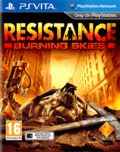You can trust VideoGamer. Our team of gaming experts spend hours testing and reviewing the latest games, to ensure you're reading the most comprehensive guide possible. Rest assured, all imagery and advice is unique and original. Check out how we test and review games here
There’s a lot of weight resting on the shoulders of Resistance: Burning Skies. Aside from the fact that it’s one of the bigger names in the Vita’s current line-up – we’re assuming it’s a launch title or at least a game due soon after the console arrives, but nothing has been confirmed yet – there’s also the fact that it’s the first portable FPS to offer twin-stick controls. In theory this could be a landmark title for handheld gaming, and everyone will be keeping a close eye on how developer Nihilistic fares with Sony’s new toy.
The early signs are promising. Burning Skies promises to be a proper FPS with all the trimmings, and the gamescom 2011 demo certainly marks a departure from the diluted genre efforts we’ve seen in the past. When all’s said and done, it really does make a difference having two analogue sticks to govern your movement and aiming, even if their sensitivity and diminutive size take a bit of getting used to. This isn’t some bodge-job facsimile of the standard FPS control setup, it’s the genuine article. And that means it’s very easy to delve straight into the messy business of shooting Chimera in the head.
Beyond the two sticks, there are other attempts to integrate the Vita’s functions into the standard FPS fare. The front touchscreen is put to good use, allowing the player to trigger alternate fire options swiftly and efficiently. For instance, there’s a new Chimeran weapon called the CRG that has the ability to fire multiple homing rockets; to enable this, you simply tap on the enemies you wish to target and then hit the usual fire button.
Since our new protagonist, Tom Riley, is a fireman by profession, we also get an on-screen button for triggering melee attacks with a nasty-looking axe; get the timing right and the blade will lodge itself in your foe’s neck, triggering a brief extended kill animation. A similar iPhone game-like button is used to even greater effect for the handling of grenades, allowing you to precisely aim where your explosives go by dragging an arc from the icon to the target. By dragging slowly, you can also cook the grenade so that it explodes as soon as it’s lobbed – or goes off in your hand, if you’re too slow to take action.
Only the cover system falters in its efforts to utilise the console’s inner gadgetry. Crouching near a suitable object puts you into a Killzone 3-like stance that protects you from harm until you pop-up to return fire. The promoted way to do this involves tilting the Vita in the relevant direction – a method that is as impractical as it is gimmicky. Thankfully you can just use the aim button instead, and under these circumstances the mechanic performs solidly.
As an early indicator of the Vita’s graphical capabilities, Burning Skies acquits itself well. Its depiction of 1950s New York under attack is easily comparable to the PS3 games, and while textures are less impressive up close than at a distance, there’s no shortage of detail on display. The frame rate remains consistent but currently appears to be slightly less than 30FPS, to my untrained eye – though there’s still time for that to get tweaked before release day.
As it stands, the gamescom demo offers an engaging 10-minute slice of sci-fi blasting, and perhaps the biggest compliment I can pay Burning Skies is that I largely forgot to think about the usual questions that crop up when playing a portable FPS. As an early indicator of what the PlayStation Vita can do, it’s an encouraging sign indeed.

/https://oimg.videogamer.com/images/da22/resistance_burning_skies_3.jpg)






